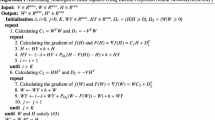Abstract
This paper contributes to study the influence of various NMF algorithms on the classification accuracy of each classifier as well as to compare the classifiers among themselves. We focus on a fast nonnegative matrix factorization (NMF) algorithm based on discrete-time projection neural network (DTPNN). The NMF algorithm is combined with three classifiers in order to find out the influence of dimensionality reduction performed by the NMF algorithm on the accuracy rate of the classifiers. The convergent objective function values in terms of two popular objective functions, Frobenius norm and Kullback–Leibler (K-L) divergence for different NMF based algorithms on a wide range of data sets are demonstrated. The CPU running time in terms of these objective functions on different combination of NMF algorithms and data sets are also shown. Moreover, the convergent behaviors of different NMF methods are illustrated. In order to test its effectiveness on classification accuracy, a performance study of three well-known classifiers is carried out and the influence of the NMF algorithm on the accuracy is evaluated. Furthermore, the confusion matrix module has been incorporated into the algorithms to provide additional classification accuracy comparison.



Similar content being viewed by others
References
Berry MW, Browne M, Langville AN, Pauca VP, Plemmons RJ (2007) Algorithms and applications for approximate nonnegative matrix factorization. Comput Stat Data Anal 52(1):155–173
Che H, Wang J (2018a) A nonnegative matrix factorization algorithm based on a discrete- time projection neural network. Neural Netw 103(1):63–71
Che H, Wang J (2018) A collaborative neurodynamic approach to symmetric nonnegative matrix factorization. In: The 25th international conference on neural information processing (ICONIP), pp 453–462
Chellaboina V, Haddad WM (2003) Authors’ reply—comments on is the Frobenius matrix norm induced? IEEE Trans Autom Control 48(3):519–520
Gantz J, Reinsel D (2012) The digital universe in 2020: big data, bigger digital shadows, and biggest growth in the far east. IDC-EMC Corporation, Washington
Gong M, Jiang X, Li H, Tan KC (2018) Multiobjective sparse non-negative matrix factorization. IEEE Trans Cybern 49(8):2941–2954
Gorski J, Pfeuffer F, Klamroth K (2007) Biconvex sets and optimization with biconvex functions: a survey and extensions. Math Methods Oper Res 66(3):373–407
Guan NY, Tao DC, Luo ZG, Yuan B (2012) NeNMF: an optimal gradient method for nonnegative matrix factorization. IEEE Trans Signal Process 60(6):2882–2898
Kim H, Park H (2008a) Nonnegative matrix factorization based on alternating nonnegativity constrained least squares and active set method. SIAM J Matrix Anal Appl 30(2):713–730
Kim H, Park H (2008b) Toward faster nonnegative matrix factorization: a new algorithm and comparisons. In: Proceedings of the eighth IEEE international conference on data mining, pp 353–362
Le X, Wang J (2014a) Robust pole assignment for synthesizing feedback control systems using recurrent neural networks. IEEE Trans Neural Netw Learn Syst 25(2):383–393
Le X, Wang J (2014) Neurodynamic optimization approaches to robust pole assignment based on alternative robustness measures. In: Proceedings of the international joint conference on neural networks (IJCNN), pp 1–8
Le X, Wang J (2017) A two-time-scale neurodynamic approach to constrained minimax optimization. IEEE Trans Neural Netw Learn Syst 28(3):620–629
Lee DD, Seung HS (2001) Algorithms for non-negative matrix factorization. Adv Neural Inf Process Syst 13(1):556–562
Li X, Cui G, Dong Y (2017) Graph regularized non-negative low-rank matrix factorization for image clustering. IEEE Trans Cybern 47(11):3840–3853
Lichman M (2013) UCI machine learning repository, School of Information and Computer Science, Irvine, CA: Univ California. http://archive.ics.uci.edu/ml/
Lin CJ (2007) Projected gradient methods for nonnegative matrix factorization. Neural Comput 19(10):2756–2779
Tang B, He H (2015) ENN extended nearest neighbor method for pattern recognition. IEEE Comput Intell Mag 10(3):52–60
Wang S, Deng C, Lin W, Huang GB, Zhao B (2017) NMF-based image quality assessment using extreme learning machine. IEEE Trans Cybern 47(1):232–243
Xia Y, Wang J (2000) On the stability of globally projected dynamical systems. J Optim Theory Appl 106(1):129–150
Xiao Y, Zhu Z, Zhao Y, Wei Y, Wei S, Li X (2014) Topographic NMF for data representation. IEEE Trans Cybern 44(10):1762–1771
Xu B, Liu Q, Huang T (2019) A discrete-time projection neural network for sparse signal reconstruction with application to face recognition. IEEE Trans Neural Netw Learn Syst 30(1):151–162
Zhang N, Leatham K (2017) Feature selection based on SVM in photo-thermal infrared (IR) imaging spectroscopy classification with limited training samples. WSEAS Trans Signal Process 13(33):285–292
Zhang N, Karimoune W, Thompson L, Dang H (2017) A between-class overlapping coherence-based algorithm in KNN classification. In: The 2017 IEEE international conference on systems, man, and cybernetics (SMC), pp 572–577
Zhang N, Xiong J, Zhong J, Leatham K (2018) Gaussian process regression method for classification for high-dimensional data with limited samples. In: The 8th international conference on information science and technology (ICIST), pp 358–363
Acknowledgements
This work was supported in part by the DoD Grant #W911NF1810475, National Science Foundation (NSF) grants, HRD #1505509, HRD #1533479, and DUE #1654474.
Author information
Authors and Affiliations
Corresponding author
Additional information
Publisher's Note
Springer Nature remains neutral with regard to jurisdictional claims in published maps and institutional affiliations.
Rights and permissions
About this article
Cite this article
Zhang, N., Leatham, K. A neurodynamics-based nonnegative matrix factorization approach based on discrete-time projection neural network. J Ambient Intell Human Comput 14, 1–9 (2023). https://doi.org/10.1007/s12652-019-01550-5
Received:
Accepted:
Published:
Issue Date:
DOI: https://doi.org/10.1007/s12652-019-01550-5




